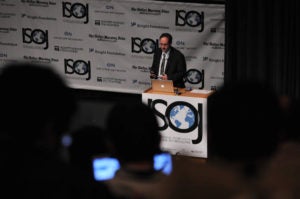May 28, 2013 | Research, Social Media
Not your typical news audience – anymore
Assistant Professor of Media Culture at the College of Staten Island (CUNY), C.W. Anderson, chaired a panel of academics from universities across the U.S. and Canada discussing the importance of community in the news today at the 14th annual International Symposium on Online Journalism.
Four experts presented their findings from research conducted on a particular topic pertaining to the evolution of journalism during a discourse entitled “Not Your Typical News Audience-Anymore.” Each presentation discussed information primarily concerning the dissemination of news through the use of social media.
The first paper, presented by Irene Serrano Vazquez of Concordia University, Canada, discussed the growth of technology and the effects of audience participation in journalism. Her research examined the importance of user-generated content. Vazquez placed emphasis on how audiences are not “abstract,” or difficult to understand. She said she has discovered a tool-kit based on the, “study of audiences, journalists, content, context and tools for a critical investigation on how audiences’ participation is affecting journalism.”

The following article, written by Geoffrey Michael Graybeal of the University of Hartford, discussed the resignation of student editors of the Red and Black, an independent newspaper at the University of Georgia. The originally student-run newspaper was taken over by professional journalists at the beginning of the 2012-2013 school year, which caused the students to break off and created a “rival digital publication” called the Red and Dead. The team, “took to Twitter to spread news of their cause using the hashtag #redanddead,” according to Graybeal. By spreading the news of their cause through social media, the former staff members were able to receive national recognition and within the first three days had their stories published in The New York Times, the Associated Press and The Washington Post. Graybeal’s findings demonstrate, “how highly-connected Twitter users functioned in the formation of viral news.”
Avery Holton of the University of Texas presented the third paper that is best summed up by its title, “Soliciting reciprocity: Socializing, communality and other motivations for linking on Twitter”. The main questions his study asked was,“what motivates people to post external links in their tweets?” His findings revealed eight motivating factors that answer this question –information seeking, information sharing, interpersonal utility, convenience and entertainment, passing time, social support, control and promoting work, and communal reciprocity. Communal reciprocity is the key influencer behind not only linking on Twitter, but why it is such a common news source. Holton compared linking on Twitter to butterflies trapped in a jar; the best way for a full story to be released (or read) is for it to be circulating among a community on social media.
ISOJ 2013: Avery Holton presents his research during the “Not Your Typical News Audience – Anymore” panel from Knight Center on Vimeo.
Lastly, Jonathan Groves of Drury University discussed his study that he conducted over four weeks of observing the Christian Science Monitor struggling to engage their audience, despite being a digitally-focused news organization. According to Groves, the publication relied too heavily on defining themselves in terms of their history. In one of the more than 60 interviews that Groves conducted, one of the staff members said that in terms of engagement they were, “just blind and fumbling around in the dark.” The publication’s latest survival technique is based on page views. Groves concluded that their lack of participatory journalism, or user-generated content, has led them to not knowing the advantages of using audience engagement for their benefit. Public contribution will be necessary in order to build a strong audience. In a closing remark, Groves said, “they aren’t thinking in terms of behavior, they aren’t guiding the conversation, they are trying to control it, this doesn’t allow a community to build.”

